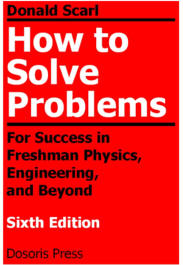Reviews
"Scarl's book is well written and clearly aimed at students. It contains numerous examples and chapter-end exercises, most which are drawn from elementary mechanics, and a collection of twenty-five problems and worked-out solutions in the author's format. ...Both students and instructors will find the book a good source of practical ideas for solving quantitative homework and test problems in basic science and engineering courses.
Richard M. Felder, North Carolina State University
Chemical Engineering Education 29, 157 (Summer 1995)
This handbook offers an inexpensive, sequential, systematic approach to problem solving. It is an ideal supplementary resource for students taking introductory physics or engineering courses at the high school or college level. High-school physics teachers and college instructors will find Scarl’s book useful as a graphic organizer for teaching the systematics of routine physics problem solving.
Scarl’s philosophy of lifelong learning emerges to set a tone that physics problem solving can be done by all who wish to tackle it as a challenge. His wisdom, experience teaching physics, and problem-solving tactics address many of the barriers novices face when attempting to solve problems in physics. He deals with their fear of making mistakes or presenting their work to others. His no-nonsense approach to solving problems in physics breaks through the barriers individuals construct when first encountering the mathematical domain of physics.
The author's writing matches his approach to problem solving. It is succinct, precise, clear, and easy to read. The reader who enters Scarl’s world of problem solving finds that “impossible” physics problems have an approachability that was lacking before introduction to his strategies. He makes it clear that the methods he advocates are not the only way to approach and solve problems, but they work for a large majority of people. .In brief, his approach is to dissect the problem into its relevant parts, identify variables assigning labels and symbols, develop appropriate diagrams or drawings, identify pertinent formulas, and then sequentially move from the knowns or givens to find the unknowns.
Finally, Scarl incorporates the use of technology, highlighting the use of spreadsheets to help physics problem solvers tackle calculations, data organization, and graphic design. His examples make clear the ease with which equations needing multiple values for a given variable can be made in order to display results graphically or calculate an integral numerically. As with his descriptions of prior methodology, his approach to the use of spreadsheets and graphs is succinct and systematic.
No problem-solving handbook would be complete without practice problems for the readers, and Scarl doesn’t disappoint us. He concludes the handbook with challenging physics and engineering problems. Yes, the systematic strategies and solutions are also included.
M. Jenice French, Center for Science and Mathematics Education and Elementary Education, Kansas State University, Manhattan, KS 66506
Reprinted with permission from The Physics Teacher, 34, 120 (February 1996). Copyright 1996 American Association of Physics Teachers.
